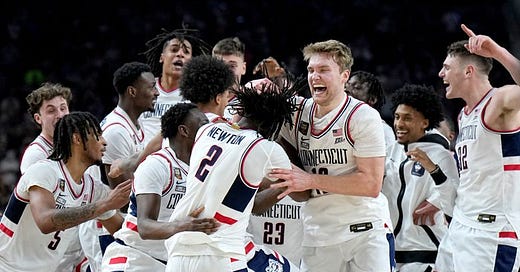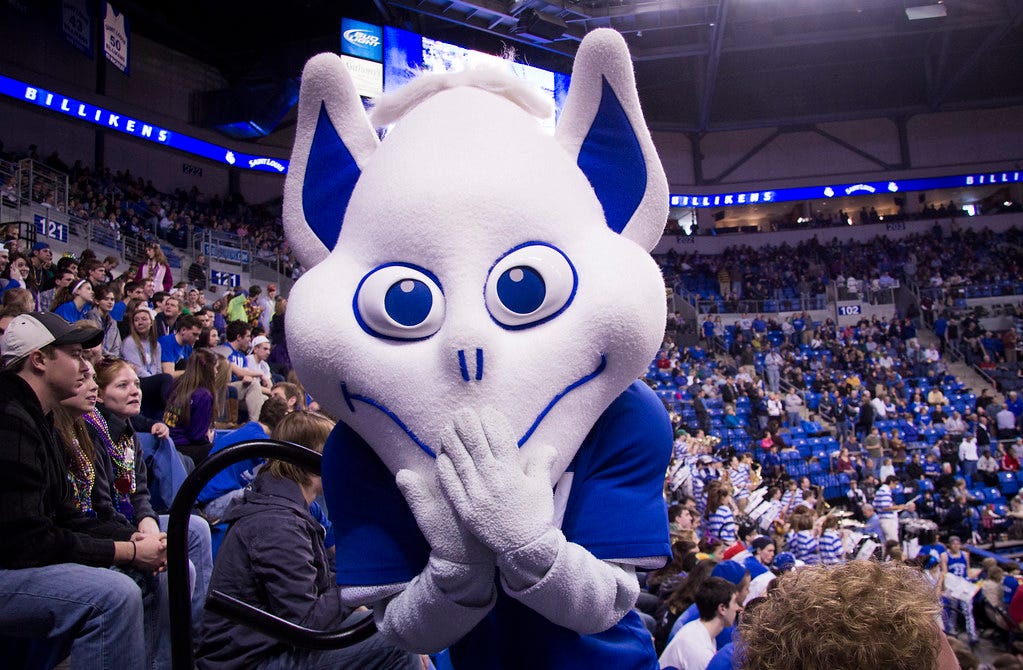In basketball, 30 million is a rare number. Not on a cap sheet, sure, but when it comes to TV ratings, you hardly ever see it. In the NBA, only a short list of games have ever crossed that threshold:
Game 7 of the 2016 Finals between Steph’s Warriors and LeBron’s Cavs
Every deciding game for every MJ title, as well as a handful in the middle of those series (this guy was pretty popular, you may have heard)
Game 7 of the 1988 Finals between Magic’s Showtime Lakers and Isiah’s Bad Boy Pistons
That’s it! Ever.
In all the years of Bird and Magic, they never got there, topping out at about 28.67M in the last chapter of their rivalry in 1987. And that’s not to detract by any means, as they really put the league on the map as a popular entertainment product.
But the fun fact there is that Bird and Magic did cross 30M. They just didn’t do it in the pros.
They did it in college. Their 1979 NCAA Championship game hit 35 million, more than any MJ game other than Game 7 of The Last Dance Finals.
Back in the day, the 30-spot wasn’t that unusual for the college final. It got there in 1982, 1983, 1985, 1987, 1989, 1992, 1993 and 1994, and only barely missed in many of the intervening years.
For a solid fifteen years or so, the average viewership was 30.6742 million people. As we established above, that’s a number the NBA — now generally understood to be a bigger deal than the college game — could only consistently clear with the help of Jordan, quite possibly the most famous athlete to ever live.
It speaks to the power of college basketball at its peak. The thing about peaks, though, is it tends to go downhill from there.
That 1994 final was the last time the NCAA Championship got there. It’s come kinda close twice since, with Arizona-Kentucky in 1997 (shouts to Mike Bibby) and Duke-Wisconsin (shouts to Frank Kaminsky) in 2015. No other game cleared 28M.
For context, this week’s final came in under 15M, and it’s rare to see it cross 20M anymore. Much has rightly been made of the far bigger numbers brought in by Caitlin Clark and Dawn Staley in the women’s final, which also didn’t clear 20M, but did bring in a record 18.7M for their side of the bracket.
And don’t get me wrong, that’s very impressive. It shows the audience for the women’s game is growing while that of the men’s game sure appears to be shrinking.
Why? It’s hard to do much more than speculate, but these are the main factors that come to mind.
How… Could This Have Happened
First off, TV ratings have always been an imperfect approximation of who might have been watching, and we’ve gotten worse at capturing that since the rise of streaming. So maybe there’s an undercount factor.
Second, TV ratings have gone down in general over time. We are not the monocultural nation we once were, though you wouldn’t know it from the Super Bowl.
So, okay. Fan behavior has changed. But so has college basketball. It’s changed a lot since the late 70s, that’s for damn sure.
The one everyone talks about now is the lack of continuity. It’s hard for a sport with such sweeping turnover to hold as much interest. It’s often a wholly new roster, year in, year out, which makes it tough for fans to connect with these players. And I think that’s probably a factor.
Until the Fab Five, the received wisdom had always been that an all-freshman starting five just couldn’t be successful. They might have talent, but they wouldn’t have chemistry, so they couldn’t win. And there’s some truth to that. Carmelo Anthony, Anthony Davis, and Jahlil Okafor are the only one-and-done stars to win it all, though Derrick Rose came close too.
But why does the one-and-done rule even exist? I wrote about this a while back if you want a longer refresher, but the short answer is this: NBA executives were mad that their teams weren’t doing a very good job scouting high school players.
They wanted to mandate the controlled environment of the college game to make their jobs easier. The added benefit for college teams was getting access to talent that would have never stepped foot on campus unless they had to.
Speaking of received wisdom, it used to be widely held that a high school player couldn’t come straight into the NBA and be successful. Starting in 1995, eventual Hall-of-Famers like Kevin Garnett, Kobe Bryant, Tracy McGrady, LeBron James and Dwight Howard came in and proved that wisdom very unwise indeed.
Did that impact viewership for the college game? I’m gonna go ahead and say it did. Basketball is a sport that bets the house on its stars. They’re its greatest asset. But those stars are having shorter careers in college, and they have been ever since they saw it was possible to achieve their dreams of going pro sooner.
The first big ratings swoon for the NCAA final came in 2000. After the prior year’s final, when UConn got the first of its now-six titles by upsetting Duke, three Duke players — most notably sophomore Elton Brand, who went No. 1 overall — became the first players under Coach K to ever declare early for the NBA draft.
For me, that speaks to a shifting power balance. The college game was declining in importance. And not for nothing, it stands to reason that strict bans on college stars making money were not a small factor in pushing college players toward the pros earlier and earlier. They had seen it was possible, and they wanted to try. Who could blame ‘em?
That trend kept up, and now, unless a freshman season goes very poorly — and often even if it does — anyone with a good shot at getting drafted tends to bolt.
Now, the combined forces of the transfer portal and NIL have further disrupted continuity, and it’s still possible that we see that further impact fan interest. I’d just point out that the decline began a long time ago.
Will it ever recover? I don’t know. But if we set what has changed aside from what could still, then I think there’s at least a path. The sport itself isn’t in as terrible shape as you might’ve heard.
It stands out to me that one of the prevailing complaints of today’s era — the impossibility of building a true capital-P Program anymore, rather than a rotating cast of players bound for the NBA or another school — was just contradicted by the first repeat champion in 17 years.
Dan Hurley has built a Program, and I’d argue guys like his opponent in the final — Matt Painter at Purdue — as well as Kelvin Sampson at Houston and Mark Few at Gonzaga have managed to do just fine with both player movement and NIL, all at programs that do not rank among the very richest in the sport.
John Calipari, newly off to Arkansas, will be trying his own approach, full of tasty Tyson/Walton dollars ready to be deployed. Maybe he’ll build a Program too.
Who’s to say! I loved this year’s tournament. I watched more than I had in years, and the first weekend of March Madness is still my favorite neutral-fan sporting event. It’s still got me. Long live the Madness.
Also, This
I’m also watching a lot more baseball. I (rightly) lost hope in my beloved Cardinals somewhat early on last year, and though I’ve been more encouraged by the early returns this year, I’m also wondering: did the NL Central just go from the worst division in baseball to the best? It’s them and the AL East right now, which is wild to me. This has to just be some small-sample size noise, but jeez. Didn’t have that one on my bingo card.
Staying in the Lou, very glad to see SLU bring in Josh Schertz from Indiana State. When I was growing up, that was a semi-respectable Program under the late Rick Majerus, and it hasn’t been since, so I’m hoping Schertz can bring it back. Because if anything can contribute to the state of college basketball, it’s probably more of this little freak, right?
Ohtani’s former interpreter, Ippei Mizuhara, is reportedly negotiating a guilty plea, which must have the Dodgers and MLB exceedingly pleased. Maybe this does go away for them after all. Prosecutors now believe Ippei was indeed stealing money from Shohei, and allegedly stole more like $16 million in all, which would help explain the mountain of gambling debt. I’ll be keeping an eye on this one, but know that I’m marking this as a highly tentative win.
In related news, Adam Silver is indeed threatening Jontay Porter with a lifetime ban for what he called the league’s “cardinal sin” if he’s found to have placed bets on his own performance. Yikes.
And finally, in case you have missed every other notification of its existence, we finished our run on The Option this week. 6/6, all done, so go on and listen if you still haven’t:







I’m seeing a trend…maybe it’s just UConn 🥴 Great piece!